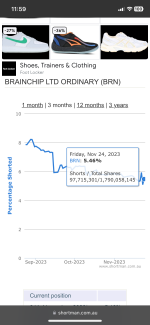You are using an out of date browser. It may not display this or other websites correctly.
You should upgrade or use an alternative browser.
You should upgrade or use an alternative browser.
BRN Discussion Ongoing
- Thread starter TechGirl
- Start date
db1969oz
Regular
ASX releases the number of shorts takin out yesterday at approximately 11am. I don’t know if there is anyway possible to find out todays?Good morning everyone! What do shorts look like today? Does anyone have an account with access to that? Thank you all!
buena suerte :-)
BOB Bank of Brainchip
Such a shame that the great man passed away yesterday, he will be sadly missed.
ndefries
Regular
GazDix
Regular
Huh? It is not night time in Larimah.In the Land of Poets and Thinkers…
Tony Coles
Regular
Hi ndefries, yesterday shorts went down to 90 million 23rd and todays 24th gone up to 97 million roughly so the cunts bought more shorts
Attachments
Sorry, ....but using that C,,, word is most disgusting. Treatment of women, many of whom visit this forum daily MUST be respectfull. There is no excuse for that. You should be ashamed.
First post in months and sadly it is in reponse to your crude and disgusting post.
As I explained to you privately words matter. Do better.
First post in months and sadly it is in reponse to your crude and disgusting post.
As I explained to you privately words matter. Do better.
HarryCool1
Regular
Hi ndefries, yesterday shorts went down to 90 million 23rd and todays 24th gone up to 97 million roughly so the cunts bought more shorts.

buena suerte :-)
BOB Bank of Brainchip
Have now dropped to 34th
Lowest since January this year!!
Would love it to drop back to some of these levels....But just wishful thinking on my part
Tony Coles
Regular
Sorry, ....but using that C,,, word is most disgusting. Treatment of women, many of whom visit this forum daily MUST be respectfull. There is no excuse for that. You should be ashamed.
First post in months and sadly it is in reponse to your crude and disgusting post.
As I explained to you privately words matter. Do better.
Thanks dippY22, sorry about that, I respect your reply, just pissed off a little, have a good day. I do apologise to all who got offended.
Oh you’re Greek !?In the Land of Poets and Thinkers…
DingoBorat
Slim
Shorts, Smorts..Have now dropped to 34th(30th last week!)
View attachment 51026
View attachment 51029
View attachment 51031
Lowest since January this year!!
Would love it to drop back to some of these levels....But just wishful thinking on my part
View attachment 51030
I can't understand why people keep going on about them
They will always be with BrainChip, no matter how successful we become.
They are like disgusting blowflies, attracted to a prime steak (or gross slugs attracted to lettuce, for the vegetarians..)
Always looking for the opportunity to get some.
But, although they have well had the upper hand lately, they do come undone from time to time (the Mercedes surge, was in a large part because of a small short squeeze, I believe).
These events can force a Company's share price into new territory, a large part of which can be maintained, with further follow through and developments, from the Company.
The value of all things is subjective, to a smaller or larger extent.
Obviously, we didn't get that last time, no new "announced" IP deals eventuated.
I think this time will be different.
BrainChip will have its "Musk" moment.
Last edited:
buena suerte :-)
BOB Bank of Brainchip
Anyone thought about using Microsoft’s Autogen and have agents to code python to use the relevant library to write the code to develop capabilities using Akida? Or develop a specific LLM based on the python Library and Python Language to have a GPT agent to develop capabilities. I am guessing this is something like using NVSIO model and then getting ChatGPT or some other LLM and an agent to do all the heavy lifting. All you need is the idea, does that make any sense?
Damo4
Regular
Anyone thought about using Microsoft’s Autogen and have agents to code python to use the relevant library to write the code to develop capabilities using Akida? Or develop a specific LLM based on the python Library and Python Language to have a GPT agent to develop capabilities. I am guessing this is something like using NVSIO model and then getting ChatGPT or some other LLM and an agent to do all the heavy lifting. All you need is the idea, does that make any sense?
I think about this at least twice a day.

Your statement re "the land of poets and thinkers" could be misconstrued as an insult to Frangipani.Germany is known as "the land of poets and thinkers" because of its rich literary and intellectual history. There are many famous German intellectuals including Kant, Goethe, Hegel, Schopenhauer, Marx, Nietzsche, Freud, Planck and @Frangipani.
Bravo
If ARM was an arm, BRN would be its biceps💪!
Definitely not intended as an insult.Your statement re "the land of poets and thinkers" could be misconstrued as an insult to Frangipani.
Similar threads
- Replies
- 0
- Views
- 4K
- Replies
- 7
- Views
- 5K
- Replies
- 0
- Views
- 3K


